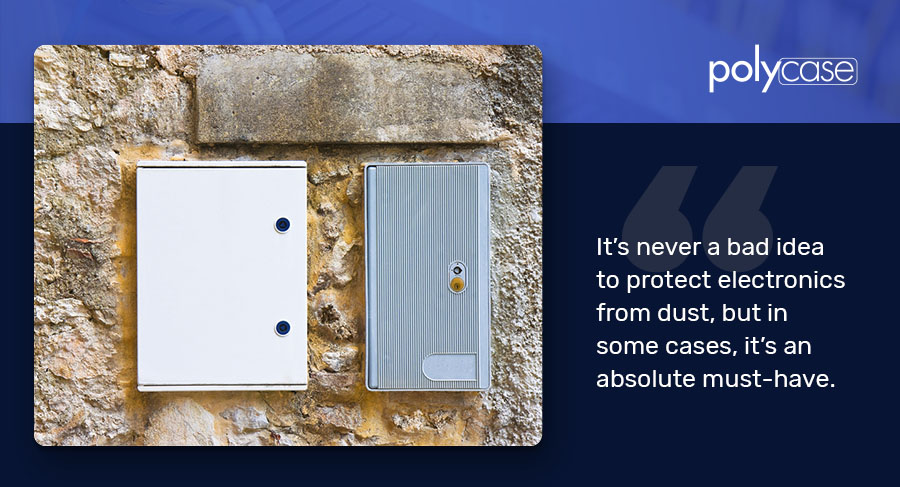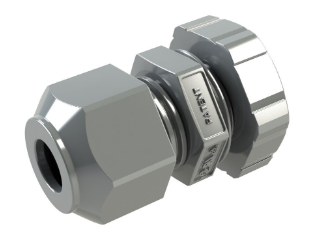- URL
Share

Floating dust, dirt and debris can do a number on electrical and electronic equipment. It sometimes only takes a few stray particles to do damage, particularly when dealing with highly sensitive equipment. That’s why device designers use dust tight electrical and electronics enclosures to protect sensitive equipment from dust and particulate matter.
What’s the secret to getting a dust tight enclosure that meets your performance needs? One of the easiest ways is by looking at the enclosure’s IP rating. In this article, we’ll talk about how to use the IP rating system to find a dust proof IP rating and lock in your ideal enclosure features. Plus, we’ll discuss how Polycase can help you find the enclosure that meets your needs and specifications.
First up, we’ll answer some basic questions about who might need a dust tight enclosure and how to use the IP rating system.
How Dust and Dirt Can Harm Electronics
Dust, dirt and other microscopic debris are constantly floating around our world. All kinds of materials are suspended in the air at any given time, including:
- Soil particles
- Plant fibers
- Human and animal skin and hair
- Insects and insect shells
- Textile fibers
- Dust mites and dust mite waste
- Paint chips
- Metal shavings
- Chemical residue
Dust in industrial and commercial environments often contains an even wider variety of materials, potentially including hazardous substances. When dust is allowed to collect on a surface or inside a device, it can create big problems for the device’s functionality and integrity.

No matter its contents, dust always poses dangers to sensitive electronic equipment, including:
- Large accumulations of dust can block vents and fans, causing air circulation and heat dispersal problems.
- Dust can serve as insulation that can cause components to overheat.
- Dust can block relays and connectors, potentially preventing devices from functioning correctly.
- Dust can gum up controls like buttons and make them difficult or impossible to use.
- Allowing dust to accumulate on electrical and electronic equipment looks unprofessional and gives the impression of disrepair and lack of care.
With all of the potential problems that dust can cause, it’s smart to take steps to mitigate the risks that dust poses to your devices. Many device designers and engineers find that dust tight enclosures are the best solution.

Applications for Dust Tight Enclosures
It’s never a bad idea to protect electronics from dust, but in some cases, it’s an absolute must-have. There are many different reasons why your application might demand a dust tight enclosure. In all of the following cases and more, a dust tight enclosure can provide the necessary protection:
- Outdoor devices that will be frequently exposed to flying sand, dirt and debris from the natural environment
- Devices that are infrequently accessed and cleaned
- Devices in machine shops, sawmills, mines, construction materials processing facilities or other industrial settings with dust and debris that circulates freely in the air
- Particularly sensitive devices that can’t tolerate any amount of dust or dirt accumulation
When an application demands serious dust protection, you need a dust proof electronics enclosure that can handle the job. You also need a way to ensure that you select the right model, and one of the easiest ways to choose is by using the international IP rating system for dust and liquid protection.
What Is a Dust Proof IP Rating?
The Ingress Protection or IP rating system is an international rating system for electrical and electronics enclosures. The system rates an enclosure’s performance against an international standard of dust and liquid protection. It’s a two-digit system, with the first digit rating the enclosure’s dust and particulate protection capabilities and the second rating its water and liquid protection capabilities.
If your application demands a dust tight enclosure, you should look for an IP rating on the enclosure that begins with the number 6, such as an IP65 enclosure, IP66 enclosure or IP67 enclosure. The 6 rating is the highest IP rating possible for dust protection and indicates a dust tight enclosure that offers total protection against dust ingress.
Generally, IP65- through IP68-rated enclosures include features such as gasket seals that will provide all necessary protection against dust and dirt when properly maintained. Which of these ratings is right for your application depends on what level of liquid protection your enclosure needs, with IP68 offering the most complete level of liquid protection.
For applications that need dust resistance but aren’t required to be completely dust tight, consider ratings such as an IP55 enclosure or IP56 enclosure as well. They offer solid dust protection and can provide additional options in features, style and price. (For more in-depth info on IP ratings, see our IP ratings guide and learn how to find the perfect rating for your enclosure.)

IP and NEMA Rating Considerations
NEMA (National Electrical Manufacturers Association) enclosure ratings are an alternative system to IP ratings. NEMA ratings cover some potential hazards, such as corrosion, that IP ratings do not include. However, NEMA enclosure ratings are mainly used within the U.S., while IP ratings have international recognition by authorities such as the International Electrotechnical Commission.
It may be appropriate to take both NEMA and IP ratings into account, depending on your industry and application. Generally, a NEMA 4-rated or NEMA 4X-rated enclosure will give you weatherproof protection, including protection against dust ingress. NEMA 4 enclosures and above include gasket seals that make them well-protected against free-floating dust and dirt.
Note that if your environment includes an explosive or combustible dust hazard, such as the dust from certain combustible metals, you may need a specially-rated NEMA enclosure. NEMA 7, NEMA 8 and NEMA 9 ratings are designed to provide protection for hazardous environments with potential explosion and fire danger. Unfortunately, Polycase does not currently offer enclosures rated for these applications.

Dust Tight Enclosures from Polycase
When you need a dust tight enclosure, it can be challenging to find just the right balance of performance, features, aesthetics and cost. Polycase makes it easy to find the combination that works for you by providing an industry-leading range of dust proof enclosure designs and materials at competitive prices.
We offer many different dust tight enclosure models and enclosure accessories that meet the dust resistance needs of even the most demanding applications. Our enclosures are UL-tested to ensure that they meet IP and NEMA standards, and we offer a leading variety of materials, including stainless steel, polycarbonate and aluminum. Among our best-selling models, you’ll find:
- The AN Series, our popular diecast aluminum enclosures that combine an attractive finish with dust tight performance. These enclosures feature IP67 and IP68 ratings, plus natural EMI protection and rugged build quality that our customers depend on every day to keep their most critical devices safe.
- The WQ Series, rugged dust proof outdoor enclosures molded from fiberglass-reinforced polycarbonate. They’re IP67/NEMA 4X rated and include stainless steel latches that resist corrosion while the enclosure’s weatherproof construction blocks out all kinds of flying dust and shavings. They are also available with either a gray or transparent clear cover, plus optional stainless steel feet and mounting accessories.
- The SA Series, IP66-rated stainless steel enclosures designed for performance as good as their looks. These enclosures include silicone gaskets, hinged doors with keyed quarter-turn latches, built-in mounting brackets and 304 stainless steel construction for extreme durability.
- The EX Series, a series of extruded aluminum enclosures designed to allow a PCB to be slotted in for plug-and-play performance. Sporting an elegant powder-coated black finish and an IP66 rating, the EX Series is perfect for desktop electronics and any application that needs compact performance paired with dust tight enclosure protection.
- Our CG Series Cable Glands, molded polycarbonate cable glands that feature either IP66 or IP68 ratings. These small devices are designed to attach a cable at the point where it enters an enclosure to prevent dust and moisture from sneaking into the enclosure. (When ordering cable glands, please check the dimensions to ensure that they match your needs.)

Polycase CG-35 Cable Gland
An enclosure with a dust proof IP rating is an essential investment for many environments and applications. Polycase is designed as a one-stop shop for dust tight enclosures with all the features you need, including customized enclosures with CNC machining and full-color digital printing. Just call our enclosure experts at 1-800-248-1233 to get started, or get your free enclosure quote quickly and easily online.
0 Comment